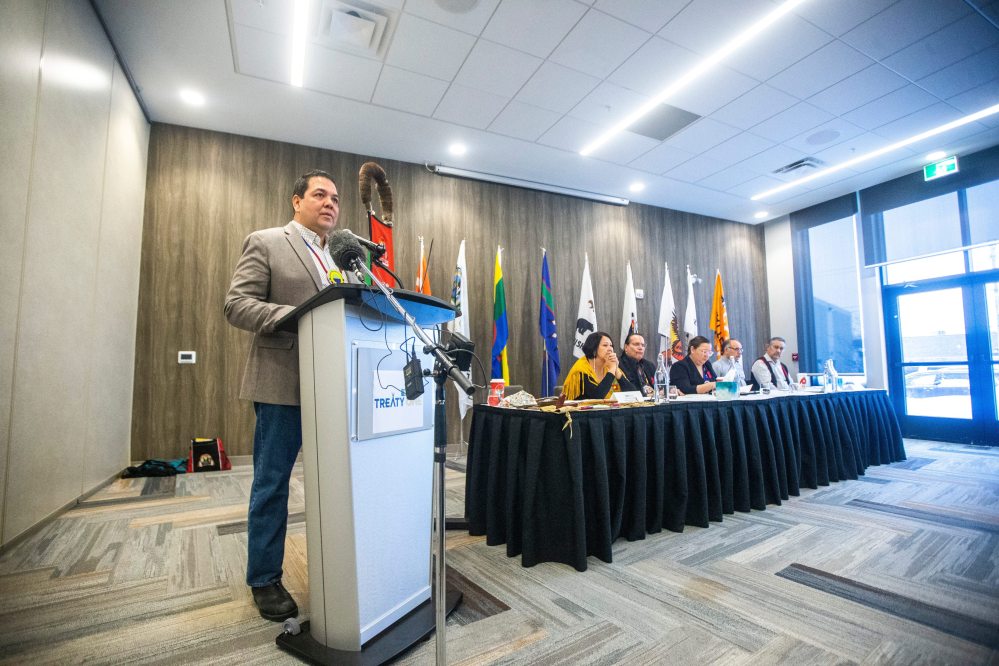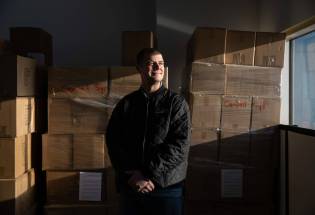Naawi-Oodena is reconciliation, about 151 years late Urban reserve on former Kapyong Barracks site is what treaties with Ottawa promised, never delivered
Read this article for free:
or
Already have an account? Log in here »
To continue reading, please subscribe:
Monthly Digital Subscription
$0 for the first 4 weeks*
- Enjoy unlimited reading on winnipegfreepress.com
- Read the E-Edition, our digital replica newspaper
- Access News Break, our award-winning app
- Play interactive puzzles
*No charge for 4 weeks then price increases to the regular rate of $19.00 plus GST every four weeks. Offer available to new and qualified returning subscribers only. Cancel any time.
Monthly Digital Subscription
$4.75/week*
- Enjoy unlimited reading on winnipegfreepress.com
- Read the E-Edition, our digital replica newspaper
- Access News Break, our award-winning app
- Play interactive puzzles
*Billed as $19 plus GST every four weeks. Cancel any time.
To continue reading, please subscribe:
Add Free Press access to your Brandon Sun subscription for only an additional
$1 for the first 4 weeks*
*Your next subscription payment will increase by $1.00 and you will be charged $16.99 plus GST for four weeks. After four weeks, your payment will increase to $23.99 plus GST every four weeks.
Read unlimited articles for free today:
or
Already have an account? Log in here »
Hey there, time traveller!
This article was published 20/12/2022 (1083 days ago), so information in it may no longer be current.
It seems fitting that the former Kapyong Barracks site on Kenaston Boulevard is the exact size a First Nations family was supposed to receive from the Crown when Treaty 1 was negotiated 151 years ago.
The treaty, signed at Lower Fort Garry near St. Andrews in 1871, stipulated, among other things, that each family of five would receive 160 acres of reserve land “or in that proportion for larger or smaller families.” Coincidentally, that is the exact size of the former Kapyong Barracks, land that was used by the Canadian Armed Forces until 2004. In some ways, it stands as a symbol of how Indigenous people were robbed of their land when the numbered treaties were signed.
First Nations in Manitoba have been battling for decades through the Treaty Land Entitlement process for the balance of land owed them under the numbered treaties. Some progress has been made. After a near-two decades legal battle, Treaty 1 First Nations announced Monday that the site, now called Naawi-Oodena (“centre of the heart and community” in Anishinaabemowin), has been officially designated an economic development zone, or urban reserve. It is the largest urban reserve in Canada.

In many ways, Naawi-Oodena is what First Nations leaders aspired to when they negotiated the numbered treaties: to share the land with newcomers, while maintaining self-government and preserving their culture, language and way of life. The site will be developed into a mixed-use community that will include residential, commercial, education, cultural, health and sports and recreation spaces. Most of it will be held and run collectively by Treaty One Nations, which signed a municipal services agreement with the City of Winnipeg.
Sadly, Naawi-Oodena is not exactly what the colonizers had in mind a century-and-a-half ago. Their idea of treaties was to push First Nations off to the side to make way for colonial settlement and to pay little more than lip service to treaty obligations. The goal was primarily to segregate Indigenous people, gradually assimilate them into white, Christian society and, ultimately, eliminate their culture, language and way of life; also known as genocide.
“The undersigned Chiefs do hereby bind and pledge themselves and their people strictly to observe this treaty and to maintain perpetual peace between themselves and Her Majesty’s white subjects and not to interfere with the property or in any way molest the persons of Her Majesty’s white or other subjects,” the Treaty 1 text reads.
In other words, you guys live over there, the white people will live over here (on the more valuable, economically viable land) and Indigenous people should try to “adopt the habits of the whites,” as Manitoba’s first lieutenant-governor Adams Archibald told First Nations chiefs during Treaty 1 talks.
Naawi-Oodena defies all of that. It represents what the treaty relationship should have been from the start: mutually beneficial agreements to live together in peace, to share the land equitably in an environment of mutual respect, with neither group subservient to the other. That is the vision First Nations had when they signed the numbered treaties. It is now embodied in Naawi-Oodena.
SHANNON VANRAES/WINNIPEG FREE PRESS FILES A model of the Naawi-Oodena master plan was unveiled at the Treaty One offices in Winnipeg in October 2021.
Colonial governments deserve no credit for this. The federal government fought the Naawi-Oodena concept at every turn, until it finally lost at the Federal Court of Appeal in 2015, following an eight-year legal battle. Ottawa didn’t want to give up the 160 acres of prime real estate to First Nations. The government wanted to keep it, just like colonial governments did in the 1870s. It was First Nations leadership that fought for this vision and ultimately won.
“There’s a paradigm shift that’s taking place,” Manitoba Keewatinowi Okimakana Grand Chief Garrison Settee said Monday during the news conference. “We’re not going to be marginalized anymore. We’re now in a position of… economic power.”
This is what reconciliation looks like. It is about reconciling the past and finding solutions to improve the future by acknowledging that treaties were signed, that they are binding and constitutionally protected. More importantly, it is about recognizing and embracing the treaty relationship, which, more than anything, is what Naawi-Oodena is all about. We have First Nations leaders to thank for bringing us to this stage in history.
tom.brodbeck@freepress.mb.ca

Tom has been covering Manitoba politics since the early 1990s and joined the Winnipeg Free Press news team in 2019.
Our newsroom depends on a growing audience of readers to power our journalism. If you are not a paid reader, please consider becoming a subscriber.
Our newsroom depends on its audience of readers to power our journalism. Thank you for your support.












